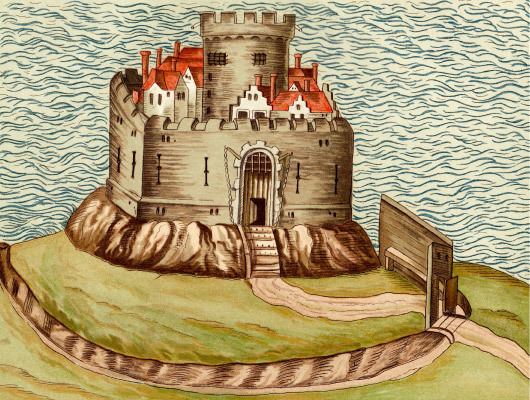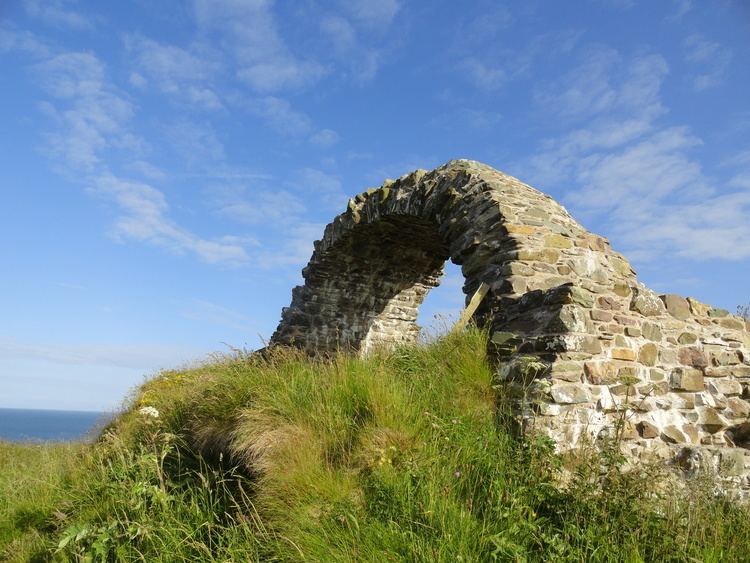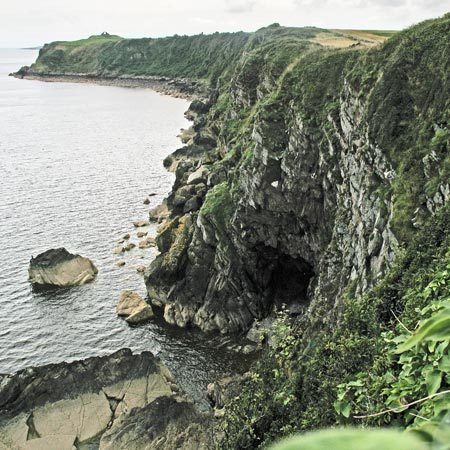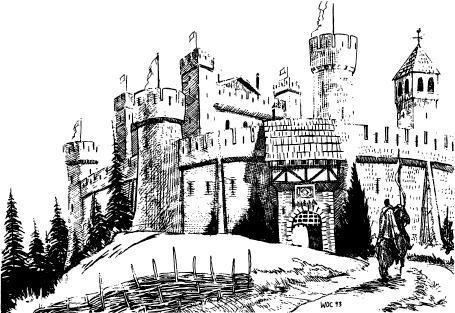Open tothe public Yes Built 13th Century | Owner Private Condition Ruined Materials Stone | |
 | ||
Cruggleton Castle known in ancient times as "The Black Rock of Cree" is a ruined castle in Sorbie Parish, Sorbie (previously Cruggletoun Parish), the Machars, Wigtownshire, Dumfries and Galloway, Scotland.
Contents
- Cruggleton Castle and former parish
- Cruggleton ruins
- Archaeology
- Cruggleton otherwise Crugilton Church
- References

It was also known as Strogilton and Srogiltona in a charter to Gilberto Kenedy, son and heir of Johannes Kenedy, in Register of the Great Seal of Scotland. Vol.I. AD1306-1424. p. 71 no.223, 2 January, year reign David II tricesimo sexto.

Cruggleton Castle and former parish

Evidence exists of a settlement at Cruggleton as far back as the 1st century, however it was not until the 12th century that a stone tower was constructed on a motte, not far from the village of Cruggleton (of which there are no remains).

The castle is located on a high outcrop of shale, part of the cliff edge, about 4 km south east of the village of Garlieston.
The name 'Cruggleton' is taken to derive from the rocky nature of the site.

In the 12th century, Cruggleton Castle was possibly a seat of the Lords of Galloway, passing to the Earls of Buchan.
In the 1290s, John Comyn, Earl of Buchan, had a licence from Edward I. to dig for lead in the Calf of Man (off the coast of the Isle of Man), to cover eight towers of the castle, quoted by Cumming (History of the Isle of Man, p. 307) to be in Chalmer's Caledonia Sir John de Soulis of Liddesdale married Buchan's sister, and therefore was a brother-in-law of Comyn.
King Robert the Bruce (reigned 1306-1329) in "Register of the Great Seal of Scotland". Vol.I. AD1306-1424, p. 514. no.92: "Carta prioris Candide case de pecia terre de Cregiltoun. (21) Candide case, of Crougiltoun, quhilke perteinit to lord Soullis". King Robert may have granted Cruggleton Castle to Whithorn Priory about AD1320, as De Soulis had his other castle "Hermitage Castle" in hands until around 1320, when William De Soulis was accused of conspiring to kill the king, Robert the Bruce. De Soulis's Hermitage Castle and lands were taken in forfeit.
King David II (reigned 1329-1371), son of King Robert the Bruce, in a charter granted the lands of Crogiltoun to Gilbert Kennedy.
Between AD1329-1371 King David II granted Gilbert Kennedy Clan Kennedy (who may have been Captain or Commendator of the Castle) "de terris de Grogiltoun Deltone Brochtowis" or Cruggleton Castle, Sorbie, Wigtownshire, "the lands of Crogiltoun and Polltoun in vice-comitatu de Wigtoun, twa Bruchtounes and Kythreull Wigtoun, Wigtoun"
In AD1424 it was granted to the Prior and Canons of Whithorn otherwise known as Candida Casa.
In AD1473 it was granted to William Douglas of Leswalt, the Douglas family. He appeared to be prior of Candecasa Cathedral (Whithorn).
In AD1563 the spies of Queen Elizabeth I of England made a coloured drawing of Cruggleton Castle that is in the British Museum, and Queen Mary of Scotland wrote a letter.
In April 1567 Lord Fleming was besieging Lord Robert Stewart, commendator of Whithorn, in the Castle of Cruggleton which belonged to the Priory.
In the AD1573 will of Michaell Howstoun (Houston) of Cottreoch, Whithorn, pp. 663–664, there was an item whereby Patrick Fleming, captaine of Crugilton / Crugiltoun, owed him 'furty pund'.
By AD1569 Cruggleton Castle was in possession of Lord Regent James Stewart Earl of Moray illegitimate son of James V of Scotland and regent for his nephew James VI and I. Crugiltoun = Cruggleton, Crugelton, Crugleton cawendis. The 10 merk land of Cruggleton was the subject of a dispute between Lord Fleming and Lord Robert Stewart, Commendator of Whithorn, between 1569 and 1583. On 23 Apr 1569 Lord Fleming had besieged the castle of Cruggleton which was in the possession of Lord Robert Stewart. On that date Earl of Moray wrote Sir Patrick Vaus to intervene between the Flemings and his brother Lord Robert Stewart, Commendator of Whithorn and later Robert Stewart, 1st Earl of Orkney also an illegitimate son of James V of Scotland. Sir Patrick Vaus was first married to Elizabeth Kennedy, a granddaughter of Margaret Fleming Stewart, Mistress of Ochiltree, Penninghame, Wigtownshire. Ultimately he obtained resolution on behalf of Margaret in 1583. Sir Patrick Vaus obtained sasine from Sir John Stewart of Minto on 24 August 1577.
In AD1585 there was an Order of Council to Alexander Stewart of Garlies to desist from the lands of Crugiltoun Cavens, etc. Lady Barnbarroch wrote to her husband re Krugiltoun. (c.AD1480s Sir Alexander Stewart of Garlies had a charter to "Alexander Stewart, son and heir apparent of William Stewart of Minto." Sir Alexander was an ambassador to England c.1485. He fought for James III of Scotland at Sauchieburn in AD1487. Sir Alexander was designated, in his father's lifetime, "Alexander of Garlies", which continued to be the chief title of the family until they were made Earls of Galloway. He was ancestor of the Stewarts, Lords Garlies and Earls of Galloway.)
On 20 January Sir Patrick Agnew, sheriff of Wigtown had a charter of con-confirmation of "terra ecclesiae parochialis de Crugiltoun," &c., being the lands which had been detached, and specially appropriated to Cruggleton Church.
In October 1586 the Laird of Garlies wrote to Sir Patrick Waus about Crugel-tone Castell.
In AD1593 Cruggleton Castle was in the "Parochia de Crugiltoun".
On 8 May 1597 the 10 merkland of Crugilton Cavenis was mentioned in a marriage settlement between John Waus, son of Sir Patrick Waus, and Margaret McDowell.
On the 27 June 1598, Sir Patrick Vaus was succeeded by his son, Sir John of Longcastle, in the ten merk lands of Cruggleton Cavens, &c., held from the commendator of Whithorn. Neither of them ever resided in the castle.
Sir John Vaus disposed of the property to Peter McDowall of Machermore, reserving the superiority, which had been obtained.
By charters of 23 September and 5 November 1606, Peter McDowall of Machermore sold it to James Kennedy, who took up residence in Cruggleton Castle. James Kennedy had married in 1600 Jane Agnew, eldest daughter of Sir Andrew Agnew of Lochnaw. The two charters of Cruggleton Castle and the contiguous lands to were "James Kennedy, and Jaine Agnew his spouse : one from Peter M'Dowall of Machcrmore, who seems to have been in actual possession under Sir John Vans, as superior ; the second from Dominus Johannes Wauss de Longcastle, miles (soldier) ; signed Barnebarroch, who, as superior, confirms the above, dated 23d Sept. 1606."
After Peter Macdowall of Machermore disponed Cruggleton castle of ancient Galloway in 1606, that Barony (MacDowall of Machermore) faded out.
On 5 September 1620, James Kennedy with consent of Jane Agnew his spouse, executed a mortgage over the lands, &c., in favour of his father-in-law, Sir Andrew Agnew.
In 1628 and 1632, there were separate sasines in favour of Agnes Cunningham, and John Fleming.
In July 1632, there was a reversion by William Cunningham to James Kennedy, of the Castle and lands of Cruggleton, with Cruggleton Cavens.
On 9 September 1633, Sir Thomas Boyd of Conchihan had sasine of the above.
On 26 December 1642 by a charter, Cruggleton Castle and lands were secured by the Agnews of Lochnaw. Andree Agnew heir of Lochnaw assigned "10 mercatas terrarum de Cruggiltoun-castle in parochia de Cruggiltoun".
On 21 November 1648, Andrew Stewart, Lord Castlestewart, was served as heir to his father, "in totis et integris decem mercatis terrarum de Crugilltoun Castle, cum decimis earundem inclusis accum castro, turre, fortalicio et manerie earundem, acetiam in toto et integris molendino de Porterack, cum terris molendinariis, astrictis multuris, solitis et consuetis omnium et singularum terrarum Prioratus de Quhithorne, cum granario addictum molendinum.... Et que tote et integre predict. terre cum molendino multuris aliisq. prescript., in capite tenenter de dict. S.D.N. rege vice commendatarij et convent. Monasterij de Quhithorne, virtute resignationis omnium Ecclesiarum in manibus dictj quondam charissimi patris, facta pro annua solutione pro prefatis terris de Cruggiltoun Castle, cum decimis earundem inclusis, triginta bollarum," &c.
On 30 April 1664, Andrew Agnew, followed by Sir Andrew Agnew, had sasine of the castle and lands.
Other owners held the castle until the late 1600s when it had become a ruin.
In the AD1684 Parish Lists for Wigtownshire, Parish of Sorbie, there were only 13 people on the list at Crugletoun, headed by William Broadfot.
On 2 January 1731, Sir William Maxwell of Monreith had sasine of Cruggleton Cavens.
On 20 February 1758, William Rorison of Ardoch had sasine of the lands of Cruggleton.
The property, however, was retained by the Agnews, who had previously obtained at the Reformation, the lands which belonged to Cruggleton Church.
Cruggleton ruins
Today the outward remains consist of a narrow section of barrel vaulting in what was the tower (known locally as 'The Arch' and clearly visible from the B7063 Garlieston-Isle of Whithorn road) and several sections of curtain wall, mostly overgrown. The motte is still clearly visible, as is the bailey ditch about 50 metres from the structure itself.
Cruggleton Castle is accessible along a coastal path from the gardens of nearby Galloway House.
Archaeology
The Machars Archaeology Project notes on Cruggleton Castle are at http://www.aocarchaeology.com/machars/2012/03/14/cruggleton-castle-barhullion-fell/
Cruggleton otherwise Crugilton Church
Cruggleton Church, (Crugilton) about 750m due west, is of Norman origin, having been established in the early 12th century by Fergus, first Lord of Galloway. It may indicate the approximate site of the village of Cruggleton.
The church itself is not directly accessible from the castle as it is located in a copse in the middle of a field. Access is available from the B7063, where it is clearly signposted. The church is locked but the key is available locally (at the neighbouring farm).
